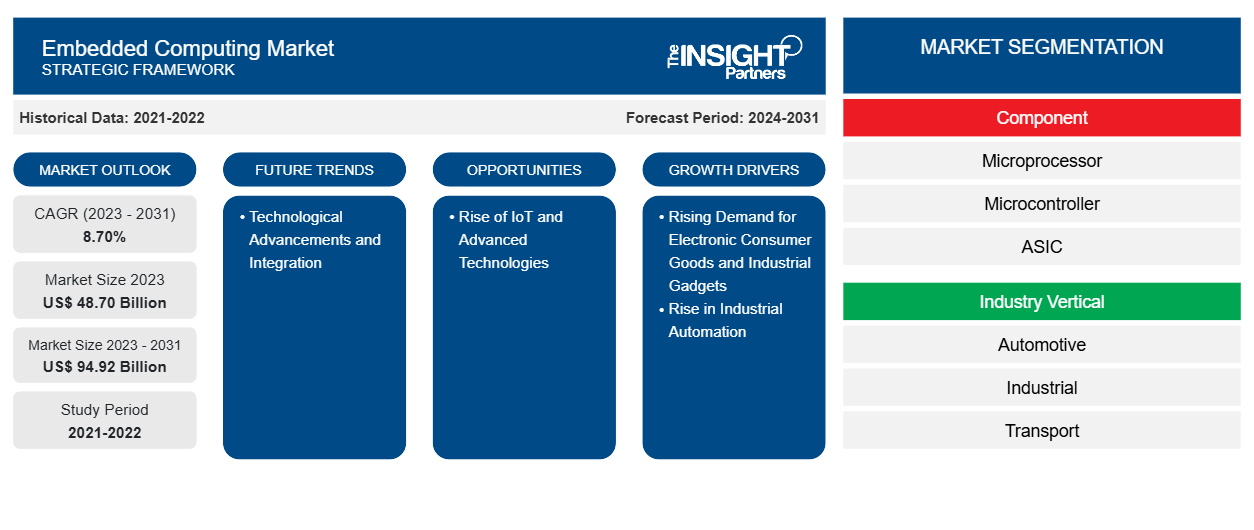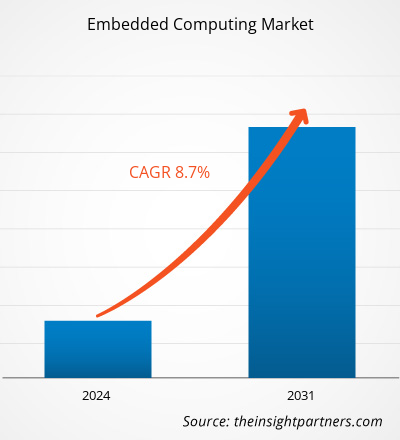The embedded computing market size is projected to reach US$ 94.92 billion by 2031 from US$ 48.70 billion in 2023. The market is expected to register a CAGR of 8.70% in 2023–2031. Escalating demand for electronic consumer goods and the rise of advanced technologies are likely to remain key embedded computing market trends.
Embedded Computing Market Analysis
The growing consciousness of environmental concerns and the escalating demand for electric and hybrid vehicles are driving the growth of the market. This market expansion is further supported by the automotive sector's restructuring, where embedded systems play a crucial role, especially in integrating ADAS technology into electric and hybrid vehicles. The anticipated global market growth is primarily driven by the rising demand for devices such as smart meters, which leverage embedded systems to offer improved clarity and functionality.
Embedded Computing Market Overview
Embedded computing systems encompass a broad array of sectors, such as domestic use, office automation, financial services, security, automotive, defense, telecommunications, consumer electronics, personal devices, healthcare, and smart card technologies. These systems are responsible for regulating, supervising, and executing specific tasks within electronic devices based on a predetermined set of instructions, procedures, or regulations.
They perform diverse operations, including interpreting sensor inputs, processing data, presenting necessary outputs, generating and transmitting commands, and transforming information. Their widespread application spans a diverse range of sectors, encompassing domestic use, office automation, financial services, security, automotive, defense, telecommunications, consumer electronics, personal devices, healthcare, and smart card technologies.
Customize This Report To Suit Your Requirement
You will get customization on any report - free of charge - including parts of this report, or country-level analysis, Excel Data pack, as well as avail great offers and discounts for start-ups & universities
Embedded Computing Market: Strategic Insights

- Get Top Key Market Trends of this report.This FREE sample will include data analysis, ranging from market trends to estimates and forecasts.
You will get customization on any report - free of charge - including parts of this report, or country-level analysis, Excel Data pack, as well as avail great offers and discounts for start-ups & universities
Embedded Computing Market: Strategic Insights

- Get Top Key Market Trends of this report.This FREE sample will include data analysis, ranging from market trends to estimates and forecasts.
Embedded Computing Market Drivers and Opportunities
Rising Demand for Electronic Consumer Goods and Industrial Gadgets to Favor the Market
The increasing need for electronic consumer products and industrial devices is a major force propelling the growth of diverse markets. This upsurge in demand is impacting the development of the medical science research market, as embedded computing technology is widely used in healthcare, automotive, artificial intelligence (AI), and other sectors. The growing understanding of the advantages of embracing cutting-edge technology, coupled with an increase in disposable income, is propelling the widespread adoption of consumer electronics globally. This surge in consumer electronics adoption is, in turn, fueling the expansion of the embedded computing market on a global scale. Furthermore, the process control and industrial automation sectors heavily depend on the design and advancement of embedded computing, serving as significant end users of key electronic components, including motherboards, microcontrollers, microprocessors, and graphics cards.
Rise of IoT and Advanced Technologies – An Opportunity for the Market
The embedded computing market is experiencing significant growth, largely due to the increasing demand for IoT (Internet of Things) devices. The proliferation of IoT devices across various sectors, including industrial automation, healthcare, smart homes, and agriculture, has notably boosted the demand for embedded computing solutions. This trend is expected to continue rapidly, with estimates signifying that there will be tens of billions of IoT devices in use over the next few years, driven by increased adoption across industries and the development of new use cases and applications. The expansion can be credited to various elements, such as the growing incorporation of IoT and connected gadgets by global organizations. Companies spanning different sectors are actively striving to integrate IoT and ensure compatibility among a variety of connected devices, household appliances, gateways, entertainment systems, and smart residences. Furthermore, the increasing sales of smart devices and wearables, coupled with a consistent uptick in the utilization of automated solutions in the industrial sphere, are propelling the industry's advancement.
Embedded Computing Market Report Segmentation Analysis
Key segments that contributed to the derivation of the embedded computing market analysis are component and industry vertical.
- Based on component, the market is segmented into microprocessor, microcontroller, ASIC, digital signal processor, FPGA, memory, and other hardware & software. The microprocessor segment held a substantial market share in 2023.
- Based on industry vertical, the market is divided into automotive, industrial, transport, consumer electronics, enterprise & government, communications, and others. The consumer electronics segment is expected to hold a significant share of the market in 2023.
Embedded Computing Market Share Analysis by Geography
The geographic scope of the embedded computing market report is mainly divided into five regions: North America, Asia Pacific, Europe, Middle East & Africa, and South America/South & Central America.
North America holds a significant position in the embedded systems market, both in terms of market share and revenue and is projected to maintain this position in the foreseeable future. This can be attributed to the rising need for connected and intelligent devices, as well as the increasing number of companies engaging in manufacturing activities within the region. Furthermore, the expanding utilization of Internet of Things (IoT) technologies is expected to further propel market growth in this area.
Embedded Computing Market Regional Insights
The regional trends and factors influencing the Embedded Computing Market throughout the forecast period have been thoroughly explained by the analysts at The Insight Partners. This section also discusses Embedded Computing Market segments and geography across North America, Europe, Asia Pacific, Middle East and Africa, and South and Central America.
Embedded Computing Market Report Scope
| Report Attribute | Details |
|---|---|
| Market size in 2023 | US$ 48.70 Billion |
| Market Size by 2031 | US$ 94.92 Billion |
| Global CAGR (2023 - 2031) | 8.70% |
| Historical Data | 2021-2022 |
| Forecast period | 2024-2031 |
| Segments Covered |
By Component
|
| Regions and Countries Covered | North America
|
| Market leaders and key company profiles |
|
Embedded Computing Market Players Density: Understanding Its Impact on Business Dynamics
The Embedded Computing Market is growing rapidly, driven by increasing end-user demand due to factors such as evolving consumer preferences, technological advancements, and greater awareness of the product's benefits. As demand rises, businesses are expanding their offerings, innovating to meet consumer needs, and capitalizing on emerging trends, which further fuels market growth.

- Get the Embedded Computing Market top key players overview
Embedded Computing Market News and Recent Developments
The embedded computing market is evaluated by gathering qualitative and quantitative data post primary and secondary research, which includes important corporate publications, association data, and databases. The following is a list of developments in the market:
- Renesas Electronics Corporation (TSE:6723), a premier supplier of advanced semiconductor solutions, today introduced the RA0 microcontroller (MCU) Series based on the Arm® Cortex®-M23 processor. The new, low-cost RA0 devices offer the industry’s lowest overall power consumption for general-purpose 32-bit MCUs.
(Source: Renesas Electronics Corporation, Press Release, 2024)
- Emerson (NYSE: EMR) today announced that it has closed the sale of a 51 percent stake in its embedded computing and power business to Platinum Equity. Emerson retains a 49 percent non-controlling interest in the business, which now operates as an independent company.
(Source: Emerson Electric Co., Company Website, 2024)
Embedded Computing Market Report Coverage and Deliverables
The “Embedded Computing Market Size and Forecast (2021–2031)” report provides a detailed analysis of the market covering below areas:
- Market size and forecast at global, regional, and country levels for all the key market segments covered under the scope
- Market dynamics such as drivers, restraints, and key opportunities
- Key future trends
- Detailed PEST/Porter’s Five Forces and SWOT analysis
- Global and regional market analysis covering key market trends, major players, regulations, and recent market developments
- Industry landscape and competition analysis covering market concentration, heat map analysis, prominent players, and recent developments
- Detailed company profiles
Frequently Asked Questions
What will be the market size of the embedded computing market by 2031?
Which are the key players holding the major market share of the embedded computing market?
What are the future trends of the embedded computing market?
What are the driving factors impacting the embedded computing market?
What is the estimated market size for the embedded computing market in 2023?
- Historical Analysis (2 Years), Base Year, Forecast (7 Years) with CAGR
- PEST and SWOT Analysis
- Market Size Value / Volume - Global, Regional, Country
- Industry and Competitive Landscape
- Excel Dataset
Recent Reports
Related Reports
Testimonials
Reason to Buy
- Informed Decision-Making
- Understanding Market Dynamics
- Competitive Analysis
- Identifying Emerging Markets
- Customer Insights
- Market Forecasts
- Risk Mitigation
- Boosting Operational Efficiency
- Strategic Planning
- Investment Justification
- Tracking Industry Innovations
- Aligning with Regulatory Trends





















 Get Free Sample For
Get Free Sample For